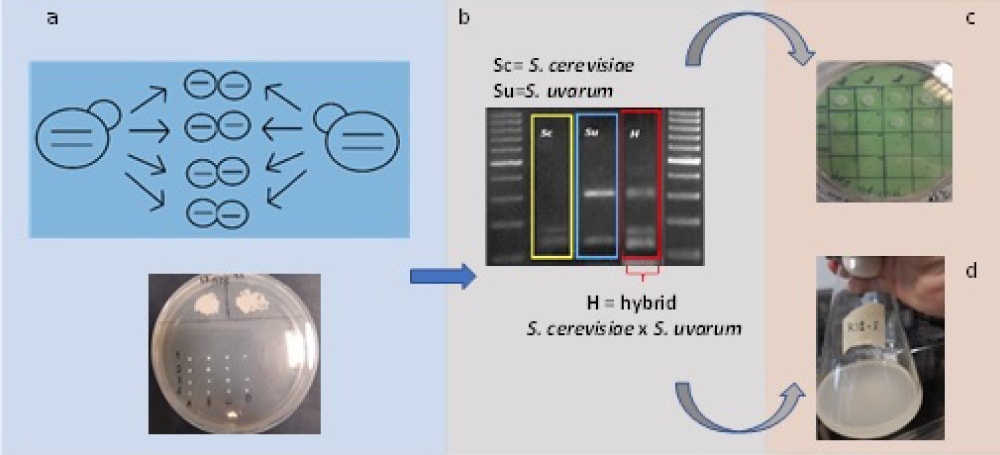
Study in collaboration with
the University of Modena and Reggio Emilia
YEASTS FOR SPARKLING WINESADAPTIVE EVOLUTION AND BREEDING STRATEGIES FOR SELECTING OPTIMISED STARTERS
Sparkling wines have a very prominent position in the wine industry and their growing popularity among consumers, who are increasingly focused on product quality, also stimulates research towards the selection of starter wines optimised for the sparkling process.
To overcome these problems and produce a good sparkling wine, it is necessary to have a good understanding of the mechanisms of fermentation and to pay close attention to all stages of production, from the vinification of the grapes to the choice of sparkling method, but above all, a suitable starter culture must be chosen.
Using unsuitable yeasts can compromise the final product, slowing down or abnormally blocking the process
In addition, the lack of oxygen prevents the synthesis of sterols and unsaturated fatty acids, altering the functionality of the yeast cell membrane.
Scientific evidence confirms the undesirable effects on yeasts, in terms of reduced activity and fermentation vigour, due to the accumulation of CO2 during the process.
Weak organic acids and their influence on cell metabolism
To better understand these effects, one must consider the action of weak organic acids, which influence the metabolism of the cell in a similar way to carbon dioxide.
In fact, CO2, even in low concentrations, forms carbonic acid, i.e. a weak acid. If one evaluates the acid dissociation constants of carbonic acid and other weak organic acids, one can see that they have roughly similar values, so the dissociative state of these molecules in intra- and extracellular matrices will be reasonably similar.
Weak organic acids at a pH value of around 3-3.5 are found in the indissociated form XCOOH, in this state they are able to freely enter the interior of the cell where the pH is 7.4. At this value they dissociate into the carboxyl anion XCOOH- and H+ ion. The carboxyl anions are unable to passively leave the membrane and accumulate within the cytoplasm. This accumulation induces various cellular responses to stress and, if left unchecked, can even induce apoptosis.
The new yeast strain obtained through interspecific breeding
The evolutionary approach can also be applied in breeding programmes to obtain both intra- and interspecific hybrids. In a first work carried out by the research group of the Unimore Microbial Culture Collection (UMCC), the evolutionary approach, previously described, allowed to obtain a new strain of Saccharomyces cerevisiae, deposited with the code UMCC 2949, having the phenotypic characteristics of interest such as, resistance to weak organic acids.
In order to validate the experimental hypothesis of the correspondence with resistance even at high CO2 concentrations, sparkling wine tests were carried out in prototype autoclaves, in which the selected strain performed well.
In order to further improve the UMCC 2949 strain, also giving it greater resistance to low temperatures, the interspecific breeding strategy was subsequently applied, crossing the S. cerevisiae strain with the UMCC 2633 strain of the S. uvarum species. The colonies resulting from the different crosses between the spores of the two parental strains were characterised at the molecular level, by means of “colony PCr” and RFLP (Restriction Fragment Length Polymorphism) analysis of the ITs-5,8s region of the rNA, in order to confirm the formation of the hybrids (see Figure 1 below).

Figure 1
Schematic representation of the interspecific breeding strategy:
a) direct spore-spore crossing between S. cerevisiae and S. uvarum strains;
b) molecular characterisation of the cultures derived from the crosses;
c) phenotypic screening;
d) fermentation tests to assess the performance of the hybrid.
The fermentation performance of the new yeast
Subsequently, the selected hybrid, named UMCC 3008, was tested on selective grounds to verify tolerance to 12% and 15% ethanol, under two different temperature conditions, 15 and 27 °C respectively, and resistance to acetic acid at 50 mM and 75 mM concentrations. The fermentation performance of the UMCC 3008 hybrid was preliminarily evaluated in microvinification tests carried out in flasks with sucrose-supplemented base wine at a final concentration of 30g/L. Finally, a BIGGY agar growth medium test was carried out for a qualitative estimate of hydrogen sulphide production.
RESEARCH RESULTS A
Phenotypic screening showed the following results for the new hybrid UMCC 3008 and the strain UMCC2949 (see Table 1 below):
- tolerance to ethanol under the conditions tested;
- resistance to acetic acid concentrations of up to 50 mM;
- low H2S production;
- good tolerance to selective pressures applied in phenotypic screening;
- excellent fermentative fitness in microvinification trials.
Therefore, it is considered that this hybrid and its ancestore are an excellent candidate as a starter cultures to be validated through further experimentation in order to confirm their fermentation performance and their suitability for the production of sparkling wines.
| Codice UMCC | Species | Ethanol 12% |
Ethanol 15% |
Acetic acid 50 mM |
Acetic acid 75 mM |
H2S (Biggy agar) |
||
|---|---|---|---|---|---|---|---|---|
| 15° | 27° | 15° | 27° | 27° | 27° | 27° | ||
| UMCC 2949 | S. cerevisiae | + | + | + | + | + | + | medium |
| UMCC 2633 | S. uvarum | + | + | - | - | + | - | low |
| UMCC 3008 | S. cerevisiae x S. uvarum | + | + | + | + | + | - | low |
Table 1
Screening for resistance to ethanol, performed on YPDA medium with 12% or 15% ethanol added (incubation at 15°C and 27°C) and acetic acid, performed on Yeast Nitrogen Base (YNB) minimal medium with 50mM or 75mM acetic acid added, in addition, qualitative evaluation of H2S production on BIGGY agar medium, after 6 days of plate incubation.


 United Kingdom
United Kingdom





